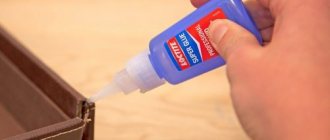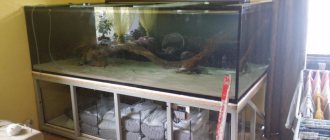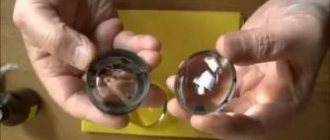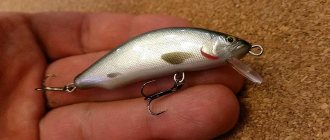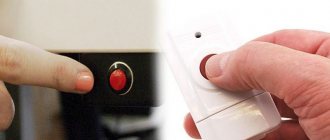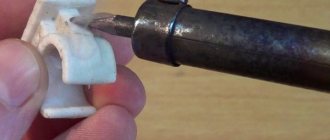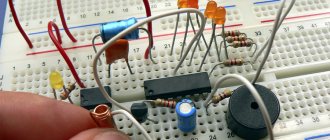Plastic welding is an effective way to lay polypropylene pipes and repair plastic products. A uniform seam is obtained by heating and melting. Special devices are designed for this. Anyone can learn to work with them. When choosing a technology, the advantages and disadvantages of each method are taken into account.
Welding plastic is the most economical technological method.
General information about welding thermoplastics
Connecting plastic parts by heating is a technology that has long been used in industrial settings and home workshops. The use of hot methods is only possible when working with materials belonging to the group of thermoplastics. This is the name for types of polymers that fully retain their characteristics after heating, melting and cooling. This is their difference from thermosets, which are destroyed by heating and final processing.
At high temperatures, such materials burn, while thermoplastics melt.
Solution 1: Gluing
This repair method is quite simple. It will require a special glue, we use dichloroethane, it is the most affordable and glues ABS plastic perfectly. You will also need a brush, preferably a synthetic one. It is convenient because after the first use, the glued hardened hairs can be trimmed, and the rest of them can be heated, the hairs will fluff up, and the brush will still serve you.
So, take a brush, moisten it in dichloroethane, apply it to the parts or parts to be glued - first on one, then on the other. It is better to put the composition in two layers, since the first, preliminary one, will begin to actively corrode the plastic... We apply the parts to each other, press and wait. Dichloroethane takes quite a long time to dry, up to six hours. With patience, we get the whole part!
Types of plastic with weldability characteristics
The joining method is chosen in accordance with the type of polymer and its characteristics.
They are distinguished by high weldability:
- Polyethylene. Products made from such plastic are joined by melting the edges, which are then combined under pressure to prevent deformation.
- Polypropylene. The material is used in the production of pipes, which are connected using a 1500 W electric soldering iron. By increasing the temperature at the junction, the 2 elements are tightly fastened. The properties of the material help to obtain a seam that does not allow moisture to pass through.
- Polyvinyl chloride (PVC). Plastic does not deform when heated. The welded joint is strong and uniform.
Polypropylene is a synthetic thermoplastic non-polar polymer.
The following polymers have medium or low weldability:
- Polystyrene. The polymer is used in the manufacture of dishes, toys, and household items. Parts made from this polymer have rather poor weldability and require careful preparation.
- Polyvinyl chloride. It is not recommended to use hot methods when comparing elements from such a polymer. This is explained by the possibility of edge deformation, which impairs the quality of the seam. Cold methods are more effective.
We recommend reading: How to solder polypropylene pipes
Technology for preparing plastic parts for soldering
First of all, you need to find out what kind of plastic the element to be repaired is made of. All of them are divided into two large groups:
It is difficult to distinguish them by appearance without many years of experience. Therefore, it is worth looking for markings on the back of the bumper or body kit elements. The most durable plastic is polypropylene. Products made from it hold their shape well, have a good appearance and can be successfully repaired.
The preparation process consists of the following operations:
- Clean off dirt and remnants of old paintwork. Mechanical cleaning is accompanied by washing with a warm soapy solution.
- Degrease. Common organic solvents, such as white spirit, are suitable here. acetone, etc.
- Sand the soldering area with velvet sandpaper (P120). Large products are polished using a grinder.
- Blow with compressed air to remove sanding dust.
Careful surface preparation allows you to achieve high quality work. A refurbished product may simply not be distinguishable from a new one.
Hot welding methods and necessary equipment
The following tools are used to connect plastic elements by heating:
- manual units that produce a stream of hot air;
- extruders;
- devices for joining sheet polymers;
- automatic welding units.
A plastic welding hairdryer can be used to join any thermoplastics.
To choose the right thermoplastic welding tool, you need to study the operating principles, advantages and disadvantages of each device.
Handheld hair dryer or gun
Together with such equipment, a consumable material is used - a rod, which is placed between the elements to be connected. After this, the seam is heated with a construction hairdryer. The device resembles a household appliance used for drying and styling hair. The temperature and power of an industrial hair dryer are higher. Thanks to this, the edges of the elements being welded are melted, forming a homogeneous mass. As it hardens, it holds the parts together.
The temperature of the air stream is adjusted automatically or manually. The kit includes attachments that help connect plastic elements end-to-end or overlapping. The nozzle configuration is selected depending on the type of plastic, the thickness of the parts, and the experience of the welder.
Household hair dryers are used to perform routine operations. Industrial options are designed for laying polymer pipelines.
Extruder
The device is similar to a gun, at the end of which there is a nozzle for fixing a filler rod or tube.
An extruder is a machine for continuous processing of polymer raw materials.
The operating principle is based on:
- heating the consumable to a semi-liquid consistency;
- removing mass to the junction of parts;
- solidification of the melt followed by the formation of a seam.
Using an extruder, you can weld elements of any thickness in one pass. The performance of the device is higher than that of a hair dryer. The main disadvantage is the inability to weld products made from different types of plastic. This is due to the difference in melting temperatures. Before starting work, the edges of the parts are cleaned of traces of dirt and grease that can impair the quality of the seam.
We recommend reading: How to solder copper pipes yourself
contact welding
The equipment produces short-term heat pulses applied in combination with pressure. The devices are used at production sites where welded polymer sheets are produced.
Tool Requirements
The most important tool in this case is, obviously, a soldering iron. Here it is quite possible to use a regular electric soldering iron or a gas torch with a power of 100 watts or more. In general, the following principle works: the greater the power of the soldering equipment, the better.
You can also use a tool such as a soldering hair dryer (or, as it is also called, a soldering gun). Actually, it is similar in principle to the hair dryer that women use after a shower. But the power and temperatures that a hair dryer can generate for soldering plastic bumpers are much higher - with its help it is quite possible to melt and solder plastic.
In addition, there are soldering stations that contain both a hair dryer, an ordinary soldering iron, and many attachments. If you have such a station, soldering any bumper will not be difficult.
Another important tool that will be useful here is a grinding machine with abrasive wheels. It is needed to remove paint and varnish from a damaged bumper. The best option is machines with a P240 wheel.
Sandpaper will also be needed during the repair process - for rubbing the putty. Finally, it is worth mentioning the additional tools that almost every craftsman has - drills with a set of drills, clamps, pliers, screwdrivers, and so on.
Gas welding
This option refers to thermal methods of joining plastic products.
How to choose gas for hot welding
Oxygen or argon is often used as a heat source. However, the most economical gas is considered to be air, which does not have a negative effect on plastic.
Oxygen, hydrogen or argon are used as welding gases.
Ultrasound method
The universal method of heat welding involves local heating of the joint to a temperature close to the melting parameter. The dosed thermal effect does not contribute to overheating and deformation of the material, which is sometimes observed when using other methods. The equipment operates with a frequency of 17-45 kHz.
Electrical vibrations turn into mechanical vibrations, which are transmitted to the material being processed.
High frequency welding
The economical method is used in many industries. Welding is carried out using 2 metal electrodes, between which a current with a frequency of 30-75 MHz circulates. A high-frequency electric field heats the edges of the parts to the required temperature. After matching, the edges are cooled naturally. The method is suitable for connecting elements with a thickness of 0.5-2 mm. In this case, 2 welding methods are used: overlap or butt.
High-frequency welding is a pressure welding method in which the edges of parts are heated by current.
Friction method
Strong friction contributes to the release of thermal energy, which partially melts the edges of the parts. Compression under high pressure leads to the formation of a uniform, strong seam. The main advantage of the friction method is high productivity. The disadvantage is that it can only be used for welding hard types of thermoplastics.
Using a laser
Due to its high cost, this technology is rarely used in domestic settings.
In industry, the laser method is used for:
- assembling cars on automated lines;
- production of electronic devices, which requires careful handling of small plastic parts;
- manufacturing of medical instruments and devices where it is necessary to create sterile conditions;
- packaging of meat and dairy products.
The laser method helps to weld structures of complex configurations. Other methods in this case are ineffective.
Surface dissolution
A simple technology is based on chemical melting of the edges followed by fixation under pressure. Heat can be used to speed up operation. The main disadvantage is the toxicity of the substances used in the work. The method is not recommended for use at home.
We recommend reading: How to solder a cooling radiator yourself
How the tool works
To successfully repair your car, determine what kind of plastic your car's bumper is made of. The most popular are hard and soft plastics. Fiberglass without markings is considered soft. Hard plastics are labeled ABS, GF30 and GF 15 or PAG6. You are unlikely to be able to accurately determine the type of material by appearance, so you will need to find the corresponding indication on the back of the car components.
Experts consider models made of polypropylene (PP) to be the most durable. They look aesthetically pleasing on any car and tolerate alignment or soldering well.
Next, you need to familiarize yourself with the technology of working with plastic, prepare equipment for work and wash the components of the car you are going to repair. If necessary, dismantle components. After this, the order of preparatory work for leveling the plastic surface is as follows:
- degrease the work surface and sand it;
- Apply a special primer for such work, glue and fiberglass to the product. Be sure to work in a protective suit;
- after the fabric has hardened, apply another layer of glue and distribute it evenly with a spatula;
- After the surface has dried, treat it with sanding paper;
- Apply a layer of varnish and enamel and secure it with varnish.
Read also: DIY dust cyclone
The result of soldering a plastic bumper
If you need to solder cracks on the surface of the car, simply clean out the crack, drill the ends and deepen the split to a depth of 5 mm to form a V-shaped groove. If the components fall apart, the parts can be connected together using a clamp.
Welding with a soldering iron is carried out at an angle of 45 degrees, slowly, using the most suitable nozzle. If necessary, the creation of a welding seam can occur in the same place repeatedly.
Selection of welding rods
These elements play the role of electrodes. They are used for soldering sheet plastic, pipes, and polyethylene objects. The size of the rods varies, as does their shape. The diameter of round bars is 3-7 mm. Rods with a square cross-section are large in size.
Plastic welding rods can be made from a wide variety of materials.
To connect polymer products, 2 types of consumables are used:
- Polyethylene rods. They have a fairly low melting point. Used for welding products made of the appropriate material using a hair dryer.
- Polypropylene rods. The elements do not deform and do not lose their working properties during long-term storage. The products are used in the assembly and repair of structures made of sheet polypropylene. Electrodes made of this material are used in conjunction with extruders that melt them to a liquid state.
Gun hair dryer
While working with a soldering iron, the material is leveled and redistributed by the tip. When working with a hair dryer, plastic filler rods are used, which are an analogue of solder when soldering or filler wire when welding.
Such rods are bought in stores or made independently by cutting up plastic waste. It is important to ensure that the rod is made of the same material as the product being repaired. The rod is sharpened on one side, and the other side is inserted into the retainer on the nozzle of the heat gun.
Which method is better for home use?
The following technologies are most often used in everyday life:
- Welding with a soldering iron. The tool has a low price, which allows it to be used even for the simplest operations. A soldering iron is used to weld pipes, containers, and car bumpers. The tool melts the surfaces at the joint, which are then matched and fixed. This method can be used to connect pipes of different diameters.
- Gas welding. At home, use a hairdryer or burner. The heated gas melts the plastic, which helps form a uniform seam. An inexpensive welding tool helps you join plastic parts of different shapes and sizes. It is used in the repair of thin-walled polymer products. The process is carried out with or without the use of filler material. Plastic rods or strips are used as consumables.
- Extruder connection. The gun is equipped with a heating element that melts the consumable material. The equipment is also equipped with a regulator that helps change the exposure temperature. Heat losses are minimal, which explains the high efficiency of the equipment.
The process of choosing a soldering iron for bumpers
Various tools are used to connect plastic parts - welding modules, soldering irons, hair dryers and guns.
All of them are united by a common operating principle - high temperature affects polypropylene or polyvinyl chloride, as a result of which the edging softens and facilitates the joining of elements.
However, different types of welding operations require different thermal tools. The operations performed by a hot-melt gun for plastic cannot replace a soldering iron or welding module. How, for example, to distinguish the first from the last.
- General information
- Operating principle of a heat gun
- Preparing for work
- Welding
